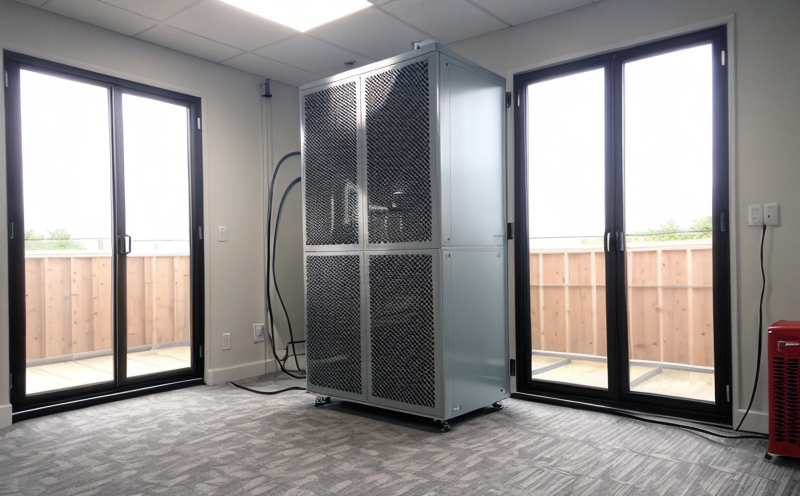Indoor Air Distribution Field Verification
In the realm of HVAC equipment testing, ensuring proper indoor air distribution is paramount to maintaining a healthy and comfortable environment within buildings. This service focuses on verifying the performance of HVAC systems through field measurements that align with industry standards such as ASHRAE 55 for Thermal Environmental Comfort and ASHRAE 62.1 for Ventilation for Acceptable Indoor Air Quality.
The primary goal is to ensure that air distribution meets design specifications, thereby promoting occupant health, comfort, and productivity. By using advanced measurement techniques, we can identify issues such as hotspots or cold spots within the space, imbalances in airflow, and areas where ventilation may not meet the required standards.
Our team of experts employs cutting-edge equipment to conduct these verifications. From particle counters to thermal imaging cameras, our tools provide precise data that help us assess the quality of air distribution. This service is particularly beneficial for facilities management teams looking to maintain regulatory compliance and enhance overall building performance.
The process begins with a thorough site survey where we gather information about the existing HVAC system. This includes understanding the layout of ductwork, grille locations, and any previous modifications made to the system. Once this data is collected, our engineers simulate various scenarios to mimic real-world conditions under which the HVAC system operates.
Using state-of-the-art equipment, we then measure parameters such as airflow velocity, temperature distribution, and air change rates at different points within the space. These measurements are compared against the design criteria specified by the manufacturer or building codes like ASHRAE 62.1-2019. Any discrepancies found during this phase are documented meticulously so that corrective actions can be taken promptly.
After completing field verifications, our team provides comprehensive reports detailing all findings alongside recommendations for improving air distribution efficiency if necessary. These insights help facility managers make informed decisions regarding maintenance schedules or potential upgrades to existing systems. Additionally, compliance with local regulations and industry best practices is ensured through rigorous testing protocols.
By leveraging this service, organizations can ensure they are providing their occupants with the highest quality of indoor air possible while also maintaining operational efficiency and reducing energy costs associated with improper airflow management.
Scope and Methodology
| Aspect | Description |
|---|---|
| Data Collection | Involves gathering initial information about the HVAC system, including its design parameters and any existing issues reported by building occupants. |
| Field Measurements | Conducts detailed measurements of airflow velocity, temperature distribution, and air change rates across multiple points within the space using advanced instrumentation like anemometers and thermal imaging cameras. |
| Simulation Scenarios | Replicates various operational conditions to better understand how different factors affect overall performance. |
| Data Analysis | Analyzes collected data against specified standards and guidelines ensuring compliance with relevant regulations like ASHRAE 62.1-2019. |
| Recommendations | Provides actionable suggestions aimed at enhancing air distribution efficiency based on identified areas of concern. |
Eurolab Advantages
At Eurolab, we pride ourselves on delivering unparalleled expertise in HVAC equipment testing. Our team comprises seasoned professionals who bring years of experience to every project they undertake. With state-of-the-art facilities equipped with the latest technology, we ensure accurate and reliable results.
We offer customized solutions tailored specifically to meet your unique needs whether it’s routine inspections or complex troubleshooting scenarios. Our commitment to quality is reflected not only in our methodology but also through ongoing training programs that keep our staff up-to-date on the newest developments within the field.
In addition to technical excellence, we understand the importance of clear communication throughout each project lifecycle. From initial consultation to final report delivery, you can expect transparent updates and proactive engagement from our side ensuring a smooth collaboration process.
By choosing Eurolab for your indoor air distribution field verification needs, you gain access to comprehensive support that goes beyond just technical expertise. Our approach ensures not only compliance with relevant standards but also optimization of operational efficiency leading to long-term benefits for your organization.
Why Choose This Test
Regular indoor air distribution field verification is crucial for maintaining optimal indoor environmental quality (IEQ). Poor air distribution can lead to numerous problems including discomfort, reduced productivity, increased healthcare costs due to respiratory illnesses, and even legal liabilities if inadequate ventilation leads to mold growth or other contaminants.
By conducting regular checks, facilities managers ensure that their HVAC systems are functioning optimally thus creating healthier environments for employees. This proactive approach not only enhances occupant satisfaction but also contributes positively towards sustainability goals by reducing energy consumption through efficient operation.
For R&D engineers working on improving existing models or developing new products related to HVAC technology, this service provides valuable real-world data that can guide design decisions and product improvements. It helps identify potential shortcomings early in the development cycle allowing for timely corrections before mass production begins.
In summary, choosing indoor air distribution field verification ensures better IAQ which directly impacts employee well-being, productivity levels, and organizational reputation. Moreover, it demonstrates a commitment to sustainable practices aligning with broader corporate social responsibility initiatives.





